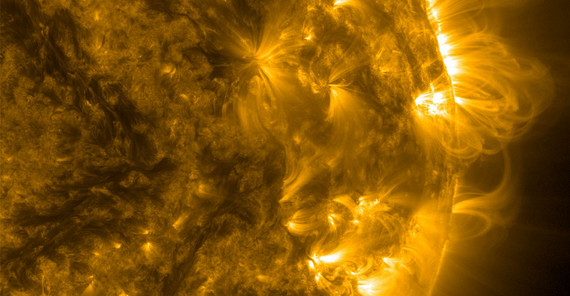They help us communicate over long distances, navigate unknown terrain, and predict the weather. Hundreds of satellites orbit the Earth servicing science, the media, the economy, and the military. Unsurprisingly, there is a great interest in protecting their sensitive technology from the particle radiation released by solar storms. In the future, data assimilation could contribute to predicting such negative effects of space weather.
Prediction and understanding of space weather is somewhat similar to the prediction of the terrestrial weather, says Yuri Shprits. With measurements from a single station we are not able to observe the entire weather system. To see a global picture we need a whole network of stations. “Similarly, for space, we get only local information from individual satellites,” says the physicist. In order to be able to better understand the complex dynamics of the system and make predictions, it is necessary to include far more satellites and develop new methods to make the best use of the data.
Yuri Shprits is Head of the Section Magnetospheric Physics at the German Research Center for Geosciences and Professor at the Department of Physics and Astronomy at the University of Potsdam. His research of the near-Earth space environment and space radiation, which is dangerous for the aerospace industry, provides an interesting field of application for data assimilation, combining incomplete and inaccurate satellite observations with information from physical models. What has already led to meaningful and reliable simulations in meteorology, oceanography, and climate research, is now also supposed to contribute to understanding the weather in space.
Shprits explains how it works. “First, we make a prediction with our model and connect it with observational data. Then, this prediction, corrected through the observations, is used as an initial condition for a new prediction, which in turn is combined with new data. “By comparing the model predictions with the actual measurements, we can deduce what physical processes are still missing in the model to better quantify it. In this way, data assimilation is not only able to reconstruct the ongoing processes in the magnetosphere but can actually give precise clues as to the physics behind them, says the scientist, who was awarded the 2012 Presidential Early Career Award for Scientists and Engineers by Barack Obama.
Within the CRC “Data Assimilation,” Shprits is collaborating with the mathematician Jana de Wiljes from the University of Potsdam to be able to apply this method to the specific field of space physics. “Jana de Wiljes not only tries to prove theories and develop abstract methods, but also to tailor them to practical problems,” Shprits emphasizes. Although theoretical experiments may be promising, the developed methods must be tested on actual data and for real-life applications. Every field and every application has its own specifications. “Sometimes we try things that work well, but we still don’t understand why. If we knew that, we would be able to optimize the methods, understand their applicability, and possibly transfer them into many other fields, such as biology, earthquake research, navigation, and climate research,” Shprits says.
He and his team are currently focusing on the Earth’s radiation belts and ring current: two donut-shaped regions that capture high-energy protons and electrons from the Earth’s magnetic field. The researchers want to understand how the particles are accelerated and spread into the atmosphere, where they can influence the climate. “The data assimilation models help us create a global picture despite sparse measurements,” Shprits says. “By comparing our analytic model with the collected data and assimilating that data, the new tools show us something that is not visible to the naked eye.”
However, it is no less important to understand how these methods work. “Otherwise we cannot rely on them,” says the physicist. “Only when we well understand them, will we know for sure that this is what really happens in nature."
The Project
Within the Collaborative Research Center 1294 “Data Assimilation”, the sub-project A02 researches the theoretical foundations of data assimilation. The sub-project B06 develops and tests “Novel methods for the 3D reconstruction of the dynamic evolution of the Van Allen belts using multiple satellite measurements”.
Duration: 2017–2021
Principal investigators: University of Potsdam, Technische Universität Berlin, GFZ Potsdam
The Researcher
Prof. Yuri Shprits studied physics and applied mathematics in Moscow, meteorology in Oklahoma, oceanography at MIT, and space physics in Los Angeles, where he also earned his doctorate. He is Head of the Section Magnetospheric Physics at the German Research Center for Geosciences and Professor at the Department of Physics and Astronomy at the University of Potsdam.
Mail: yuri.shpritsuuni-potsdampde
This text was published in the university magazine Portal Wissen - Two 2019 „Data“.

